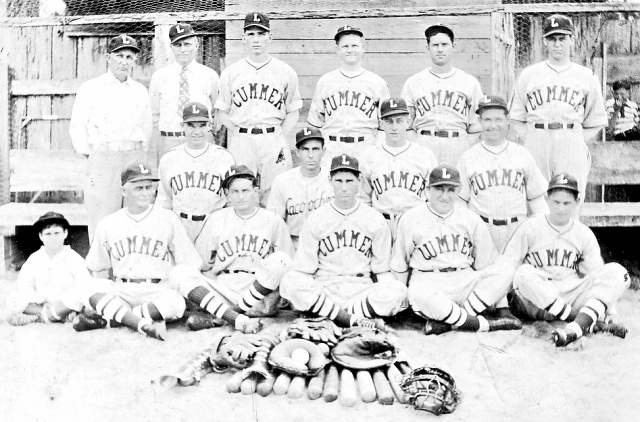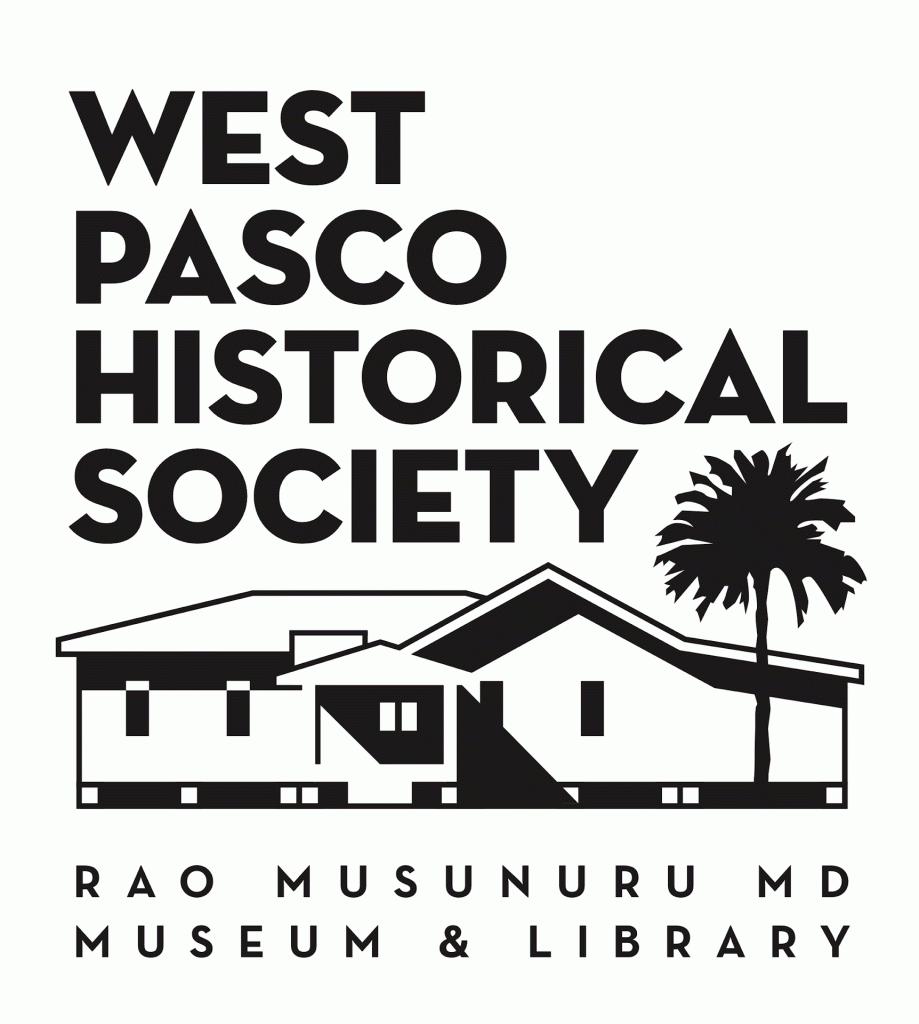HISTORY OF PASCO COUNTYLacoocheeSemi-Pro Baseball By RONALD STANLEY Baseball, a game that is played by kids and adults. Semi-professional baseball, a game? Not really, more like a way of life, an outlet for men and an opportunity for community gatherings, to relax and be entertained. During the early 20s, 30s, 40s and 50s times were hard, money hard to come by and transportation difficult. These facts of life, especially in small communities caused the citizens to take pride in and support local events. The local semi-pro teams became the focal point of pride for most small communities. This was certainly true of Lacoochee, Trilby, Dade City, San Antonio and Zephyrhills. There was furious completion with bragging rights between the teams. Games were played on Wednesday and Sunday afternoon. Lacoochee’s ballpark was located west and a little south of the old sawmill. Dade City’s ballpark was located where the new Pasco County Courthouse now stands, and was called Massey Field. San Antonio’s park was north of town next to the train depot, just west of Schrader Lumberyard. Admission was generally 10 cents to a quarter. Cold drinks and boiled peanuts were always sold at the games. On occasion, during a close game bragging rights would become very vocal and heated, sometimes resulting in a fist fight, usually ending with nothing more than a bloody nose, wounded pride and a handshake. I’m not positive when Lacoochee had its first semi-pro team. So, I will start in 1923 when my father, Jesse Stanley, started playing third base for the Lacoochee Indians. The team was sponsored by Cummer Cypress Company and played in the old West Coast League. In 1924 my father was offered a contract by the New York Giants, but turned it down thinking that he was not good enough to play in the major leagues. Stanley continued playing and became the Lacoochee Indians manager in 1942. There were a number of semi-professional baseball leagues in Florida during the 30s, 40s and 50s. Lacoochee, San Antonio, Dade City, Brooksville, Inverness, and Crystal River were part of the old Central Coast League. In 1947 Lacoochee won the Central Coast League title, a team Jesse Stanley considered one of his all time best. In 1948 the Lacoochee and Dade City teams consolidated under manager Jesse Stanley and became the Dade City Packers. They were sponsored by Pasco Packing Company. The 1948 Packers became known throughout the state as one of the best of all local clubs. Not only did they play in their own league, but played teams throughout the State of Florida, teams such as Fort Lauderdale, West Palm Beach, Bartow, Brandon, Pinecrest, Pinellas Park, Clearwater, several top teams out of Tampa, and on a number of occasions, played the State Prison team on the Prison ball field. Who were the men who played semi-professional baseball? Were they good enough to play major league ball? Why did they play? There are those among our number who played major league ball or played in the minor leagues and quit because of various reasons. They joined the semi-pro leagues because of job offers in the community, and in some cases, just to be able to play baseball. Then there are those, like my father, turned down offers for a variety of reasons. With all due respect to the major leagues, there has always been a small number of semi-pro ball players with the ability to play major league ball, and many more that could play minor league ball at entry or top level who were overlooked. To attempt to profile a semi-pro ball player who played during the 40s, 50s and 60s would be a very difficult task. The teams were made up of businessmen, professionals, common labor and young kids without resources to go to college. They were hoping to enhance their playing ability and possibly be looked at by the scouts of major league teams. All said the essence of a semi-pro player during those years was “an individual in a man’s body with a kid’s heart and a desire to play a kid’s game with great love.” It was a sad day in 1962 when semi-pro baseball came to an end in Dade City. In the South it was a way of life. We were raised to respect it as part of our Southern culture, like “yes sir and no sir” and a profound respect for our elders. Above all they played with a respect for life that seems today to be eroding inning by inning. Let us travel back in time to 1947 and visit the Lacoochee ballpark on a Sunday afternoon during the regular ball season. The stands would be full. Cold drinks and boiled peanuts would be for sale. When you looked out over the playing field you would probably see Big Cotton Hines, Charlie Ferrell Jr., Tommy Abraham, several of the North boys, Harry Sweat and a number of others “shagging” fly balls in the outfield. In the infield you might see Red Hines, L.C. North, Prevatt, Jones, McClamma and others taking hard hit ground balls from manager Jesse Stanley, getting ready for the start of the game. You would also see the starting pitchers of the day, such as Jimmy Armstrong, Arthur Ingram, or maybe Big Cotton. Perry Pitts or Vonso Sweat would be the starting catchers. You would also see the scorekeeper, Betty North, in the stands. At last, it was time, and you would hear umpire, Charlie Ferrell Sr., at home plate yell “play ball.” Before moving on in time, it should be noted here that there were other great players on the Lacoochee team before 1947, such as Johnny Pierce, Howard Rogers, Harvey Rogers, L.E. Nott, Frank Woods, Josh Groover, Marsden Baldwin, and Carmen Thompson, to name a few. If we continue our travel in time through the early and late 5os, the Wednesday and Sunday afternoon scene would remain the same. The location would change to Massey Field in Dade City and new faces would appear with some of the old Dade City faces. There were those such as Roy Hardy, Carl Deal, Wesley Ward, Mel Case and Johnny Clemmons. In the mid 50s until the end of 1962 most of the old timers had hung up their spikes, and the team had many new young faces. During this period of time the team consisted of Park Weeks, Business Manager, Jesse Stanley, Manager, and players Ward Philley, Jim Pinnell, Billy Brown, Robert Sanders, Tommy Anderton, Harry Trunnell, Mark Weeks, Pete Morgan, Jimmy Hudson, Tommy Abraham, Ronald Stanley, Fred Weeks and Dan Abernathy. I know I have left out some of the names and to those. I apologize. The story about baseball in Lacoochee would not be complete without mentioning James Timothy “Mudcat” Grant. James was born August 13, 1935 in Lacoochee. His family included his father, who worked at the mill in Lacoochee, his mother Viola, broth Julious, sisters Annie Bell and Altamese and his twin Johnnie Mae. The Grant family was one of the most respected black families in Lacoochee. James was a three sport star at Moore Academy, a segregated black school, who also played sandlot baseball on an all black team in Lacoochee. James was signed by the Cleveland Indians as an amateur free agent in 1954, as a pitcher, and made his major league debut for Cleveland on April 17, 1958. He played his final game on September 29, 1975. During that period of time he played for the Cleveland Indians, Twins, Athletics, Pirates and Dodgers. James became the first black major league pitcher to win 20 games in the American League and the first black major pitcher to win a World Series game for the American League. James now lives in Los Angeles with his wife and family, retiring after successful careers in broadcasting and community relations for major league teams. James’ brother, Julious, was also a talented pitcher, who played Triple A in the Cleveland Indian organization. He later was a twenty game winner in the Mexican League. There is a street in Lacoochee named for James called Mudcat Grant Boulevard. The boulevard leads to a park named for Jesse Stanley. James refers to Jesse Stanley as a “person who befriended me as a young man when interracial relationships were not common. He treated me and my family respect.” The boulevard and the park are a tribute to two men who symbolize baseball in this area. The article would be more accurate and complete if we had Jesse Stanley, known as “Mr. Baseball,” to tell the story of semi-pro ball during those decades. For 63 years overall, and some 34 years in Pasco County, Jesse gave of his time and talent for local adults and youngsters as well.  The following are comments regarding Prof. St. Clair and his contribution to the Lacoochee baseball teams. Jim St. Clair: I can’t write a brief history of my dad’s involvement with the Indians, because all I recall is that he sometimes pitched for the team. As I mentioned before, he had a short, weak leg from polio, so he could not run very much. Ronald Stanley: Even though he could not play much because of his disability, he did give 100 + % when he was on the field. He should be remembered in any story concerning Lacoochee and Trilby because of his prominence as an educator and as a community supporter. I certainly remember him because of the many “spankings” administered to me during my junior high school days in Lacoochee. I feel sure that all of his former students will remember that on many occasions during the hottest part of the school year “Prof” would dismiss classes early so we could all go to the river and swim. He was truly a great individual. I apologize for leaving him out in the original story. Nick Harper recalls that his father, Fred Harper, also played for the Dade City Packers. |
